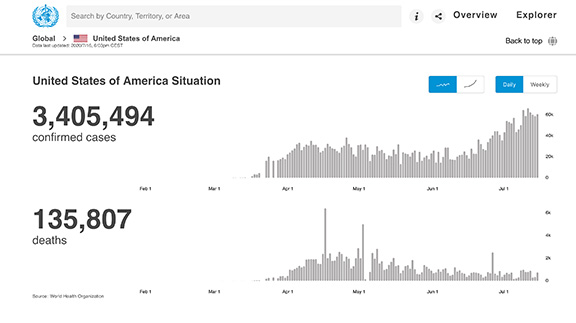By Maurita Begay
There is prevalent speculation that we are entering a “second wave” of the COVID-19 pandemic in the United States. But is this accurate?
The first case of COVID-19 in the United States was reported on January 22, 2020. As of June 25, there have been nearly 2.4 million confirmed cases with almost 122,000 confirmed deaths. There have been a total of about 31.3 million tests reported with nine percent of them having positive results for COVID-19.
At the beginning of June, there were approximately 26,700 positive cases in Minnesota and it has since steadily risen. As of June 26, there are about 34,600 total confirmed cases with 11,308 being in Hennepin county.
“We are still in the first wave… some people think a second wave will hit in the winter months, but there hasn’t been a steady decrease yet to prove that we are even done with the first wave,” a medical professional said.
This conjecture that a second wave is upon us now is based on the most recent worldwide pandemic in history, the Spanish Flu, also known as the influenza pandemic of 1918. Medical professionals and media networks are using the Spanish Flu as a parallel circumstance to the COVID-19 pandemic. However, the impact of either virus is hardly comparable because of technological advancements.
The Spanish Flu pandemic lasted fifteen months. The first wave had high numbers of infections but a lower percentage died. Yet, the few who died from their infections were often young, which is uncharacteristic of influenza. The second wave took a much higher toll, overwhelming hospitals and alarming people into practicing social distancing. By the third wave, in January 1919, the influenza virus lost some of its potency because much of the population had become immune.
Approximately one-third of the world’s population contracted the Spanish Flu. That amounted to about 500 million people. Ten percent of those cases ended in death. That was 50 million deaths worldwide, with about 675,000 occurring in the United States.
Most viruses have the same symptoms, making it difficult to differentiate without testing. Therefore, if an individual experiences symptoms of a common virus, consider that the individual may have been exposed to the coronavirus. Notably, consider practicing sanitary safety measures and social distancing to reduce the spread.
As of July 2, the total number of confirmed cases in the United States has already risen to nearly 2.7 million with over 128,000 deaths reported. That is an increase of 300,000 cases and 6,000 deaths within one week. There have been a total of almost 35.5 million tests reported with nine percent of them having positive results for COVID-19. Although the percentage of positive results displays the same number from a week ago, that does not indicate a standstill in cases because it is modified to a greater total.
Data reported by the CDC shows a precarious decrease in the number of cases reported daily in the United States somewhat between April and June, but that can only prove that lockdown restrictions were marginally effective. It also reveals the implementation of limited testing. During this time, the least reported number of cases in one day was 13,284 on May 17, 2020. However, that data unit discourages evidence of a decline because on May 16, there were 31,967 cases confirmed and on May 18, there were 24,481 confirmed.
This data, regrettably, does not reflect on the total number of cases, which has been surging to quantities equivalent to the initial outbreak. Thus, there is no consistent data to determine when the coronavirus will be contained or when the first wave will end.
Cases are still rising in Minnesota. As of July 2, there were over 37,200 confirmed cases in Minnesota, indicating an increase of nearly 3,000 cases within one week. Hennepin County accounts for 12,048 of these current cases.
The only areas showing a feasible decrease in cases in the United States are New Hampshire and Washington D.C.
As of July 2, there have been over 10.5 million confirmed cases of the coronavirus worldwide with over 500,000 deaths reported. For the end of the first wave to be declared, virus infections must be brought under control and cases must be substantially dropped. A second wave is constituted by an apparent decrease of infections in one part of a population, followed by a surge of infections in another part of a population.
Globally, we have yet to witness consistent decline in coronavirus cases. New Zealand reported a 24-day stretch without any new cases confirmed and Beijing reported 50 days, until new infections were confirmed. This data cannot maintain that the first wave of COVID-19 ceased in these areas, though. Iran appears to be approaching the criteria for a second wave, but the statistics are still ambiguous due to increased testing.
Jennifer Reeder, Indian Health Service Public Affairs Specialist, said that the Bemidji Area IHS is working closely with tribal, state, and local public health authorities in Minnesota to respond to the ongoing coronavirus pandemic, “We serve a population with underlying health conditions that would make them more susceptible to infection. We strongly encourage tribal communities to follow CDC guidelines and instructions from their local, state, and tribal governments to prevent the spread of COVID-19 and protect the health and safety of our communities.”
The Bemidji Area IHS is currently partnering with tribal casinos, hotels, restaurants, and healthcare facilities to assist in the development of COVID-19 safety plans. They are dedicated to providing a wide range of services to assist tribes with their COVID-19 response and conducting onsite safety assessments to verify the implementation of control measures needed to slow the spread.
The Minnesota COVID-19 Model, a system for making decisions using real-time information to reduce the impact of disease, suggests that more needs to be learned about the care and treatment of COVID-19 patients and social distancing needs to be in place for an extended period of time to flatten the curve. The model also discloses that mitigation efforts have not effectively slowed the spread of COVID-19 as expected. In hopeful prospects, the Minnesota Department of Health is also immersed in operating a Tribal Health Care Covid-19 Response Team and a COVID-19 Cultural and Faith Communities Engagement Team working to reach out to diverse groups to provide relief and essential information during this uncertain time.
To read more about the evolving timeline of the novel coronavirus pandemic, visit the World Health Organization’s newsroom at: https://www.who.int/news-room/detail/27-04-2020-who-timeline—covid-19.
To learn more about COVID-19 data in the United States, visit CDC’s Coronavirus information page at: https://www.cdc.gov/coronavirus/2019-ncov/index.html.
For daily updates on cases in Minnesota, visit the Situation Update for COVID-19 on the Minnesota Department of Health’s website at: https://www.health.state.mn.us/diseases/coronavirus/index.html.
To learn more about the Minnesota COVID-19 Model, visit https://mn.gov/covid19/.







